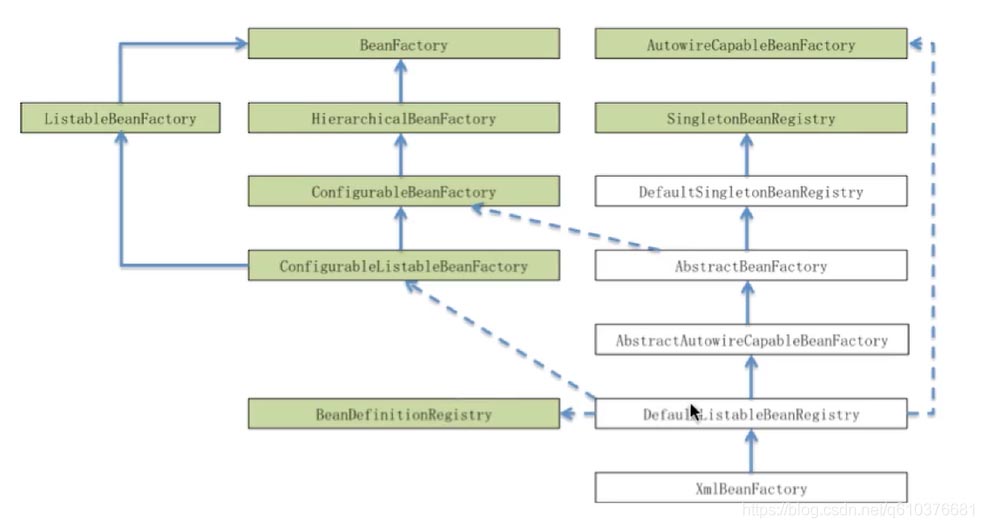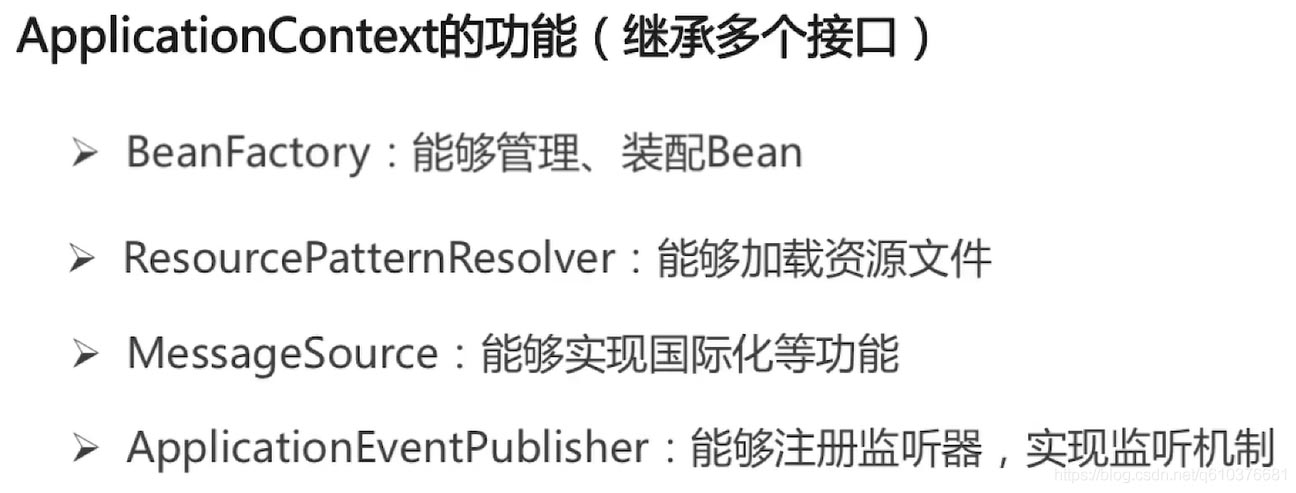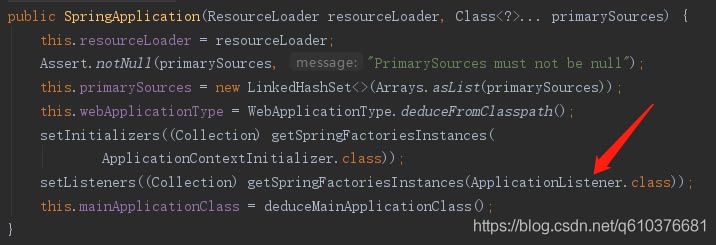Spring Bean加载与SpringBoot初始化流程 Spring中Bean的加载与SpringBoot的初始化流程详解
逆袭的小学生 人气:0前言
一直对它们之间的关系感到好奇,SpringBoot既然是Spring的封装,那么SpringBoot在初始化时应该也会有Bean的加载,那么是在何时进行加载的呢?
第一章 Spring中Bean的一些简单概念
1.1 SpingIOC简介
Spring启动时去读取应用程序提供的Bean配置信息,并在Spring容器中生成相应的Bean定义注册表,然后根据注册表去实例化Bean,装配好Bean之间的依赖关系,为上层提供准备就绪的运行环境.
Spring提供一个配置文件描述Bean与Bean之间的依赖关系,利用Java语言的反射功能实例化Bean,并建立Bean之间的依赖关系.

1.2 BeanFactory
BeanFactory是接口,提供了IOC容器最基本的形式,给具体的IOC容器的实现提供了规范。
1.2.1 BeanDefinition
主要用来描述Bean的定义,Spring在启动时会将Xml或者注解里Bean的定义解析成Spring内部的BeanDefinition.
beanClass保存bean的class属性,scop保存bean是否单例,abstractFlag保存该bean是否抽象,lazyInit保存是否延迟初始化,autowireMode保存是否自动装配,等等等
public abstract class AbstractBeanDefinition extends BeanMetadataAttributeAccessor
implements BeanDefinition, Cloneable {
private volatile Object beanClass;
private String scope = SCOPE_DEFAULT;
private boolean abstractFlag = false;
private boolean lazyInit = false;
private int autowireMode = AUTOWIRE_NO;
private int dependencyCheck = DEPENDENCY_CHECK_NONE;
private String[] dependsOn;
private ConstructorArgumentValues constructorArgumentValues;
private MutablePropertyValues propertyValues;
private String factoryBeanName;
private String factoryMethodName;
private String initMethodName;
private String destroyMethodName;
}
1.2.2 BeanDefinitionRegistry
registerBeanDefinition方法主要是将BeanDefinition注册到BeanFactory接口的实现类DefaultListableBeanFacory中的beanDefinitionMap中。
private final Map<String, BeanDefinition> beanDefinitionMap = new ConcurrentHashMap<>(256);
1.2.3 BeanFactory结构图
ListableBeanFactory该接口定义了访问容器中Bean的若干方法,如查看Bean的个数,获取某一类型Bean的配置名,查看容器中是否包括某一Bean等方法.
HierarchicalBeanFactory是父子级联的IOC容器接口,子容器可以通过接口方法访问父容器,通过HierarchicalBeanFactory接口SpringIOC可以建立父子层级关联的IOC层级体系,子容器可以访问父容器的Bean,父容器不能访问子容器的Bean,比如展现层的Bean位于子容器中而业务层和持久层的Bean位于父容器的Bean.
ConfigurableBeanFactory:增强了IOC接口的可定制性,定义了设置类装载器,属性遍历器,以及属性初始化后置处理器等方法.AutowireCapableBeanFactory:定义了将容器中的Bean按某种规则,按名字匹配,按类型匹配等.SingletonBeanRegistry:允许在运行期间向容器注册SingletonBean实例的方法.
通过这些接口也证明了BeanFactory的体系也确实提供了IOC的基础及依赖注入和Bean的装载等功能.

1.3 ApplicationContext
由于BeanFactory的功能还不够强大,于是Spring在BeanFactory的基础上还设计了一个更为高级的接口即ApplicationContext,它是BeanFactory的子接口之一.在我们使用SpringIOC容器时,大部分都是context的实现类。

我理解着就是BeanFactory只提供IOC,ApplicationContext还提供很多别的功能。

第二章 SpringBoot的初始化流程
@SpringBootApplication
public class RepApplication {
public static void main(String[] args) {
//要理解的SpringApplication
SpringApplication.run(RepApplication.class, args);
}
}
SpringApplication的run分为两个阶段,即new SpringApplication()时的执行构造函数的准备阶段,和run时的运行阶段。
public static ConfigurableApplicationContext run(Class<?>[] primarySources,
String[] args) {
return new SpringApplication(primarySources).run(args);
}
2.1 准备阶段
在准备阶段会
配置SpringBean的来源
推断web应用类型
加载应用上下文初始器
加载应用事件监听器
public SpringApplication(ResourceLoader resourceLoader, Class<?>... primarySources) {
this.resourceLoader = resourceLoader;
Assert.notNull(primarySources, "PrimarySources must not be null");
this.primarySources = new LinkedHashSet<>(Arrays.asList(primarySources));
//推断web应用类型
this.webApplicationType = WebApplicationType.deduceFromClasspath();
//加载应用上下文初始化器
setInitializers((Collection) getSpringFactoriesInstances(
ApplicationContextInitializer.class));
//加载应用事件监听器
setListeners((Collection) getSpringFactoriesInstances(ApplicationListener.class));
this.mainApplicationClass = deduceMainApplicationClass();
}
2.2 运行阶段
- 加载:SpringApplication获得监听器
- 运行:SpringApplication运行监听器
- 监听:SpringBoot事件、Spring事件
- 创建:应用上下文、Enviroment、其它(不重要),应用上下文创建后会被应用上下文初始化器初始化,Enviroment是抽象的环境对象。
- 失败:故障分析报告。
- 回调:CommandLineRunner、ApplicationRunner
public ConfigurableApplicationContext run(String... args) {
StopWatch stopWatch = new StopWatch();
stopWatch.start();
ConfigurableApplicationContext context = null;
Collection<SpringBootExceptionReporter> exceptionReporters = new ArrayList<>();
configureHeadlessProperty();
//获得监听器
SpringApplicationRunListeners listeners = getRunListeners(args);
//运行监听器
listeners.starting();
try {
//应用上下文
ApplicationArguments applicationArguments = new DefaultApplicationArguments(
args);
//环境
ConfigurableEnvironment environment = prepareEnvironment(listeners,
applicationArguments);
configureIgnoreBeanInfo(environment);
Banner printedBanner = printBanner(environment);
//依据不同的配置加载不同的ApplicationContext
context = createApplicationContext();
exceptionReporters = getSpringFactoriesInstances(
SpringBootExceptionReporter.class,
new Class[] { ConfigurableApplicationContext.class }, context);
prepareContext(context, environment, listeners, applicationArguments,
printedBanner);
refreshContext(context);
afterRefresh(context, applicationArguments);
stopWatch.stop();
if (this.logStartupInfo) {
new StartupInfoLogger(this.mainApplicationClass)
.logStarted(getApplicationLog(), stopWatch);
}
listeners.started(context);
callRunners(context, applicationArguments);
}
catch (Throwable ex) {
handleRunFailure(context, ex, exceptionReporters, listeners);
throw new IllegalStateException(ex);
}
try {
listeners.running(context);
}
catch (Throwable ex) {
handleRunFailure(context, ex, exceptionReporters, null);
throw new IllegalStateException(ex);
}
return context;
}
2.2.1 监听器分析
这个是看了源码后的个人理解,不保证一定正确,只提供一定的参考。
在准备阶段加载实现了ApplicationListener的监听器。

然后在运行阶段调用了starting()方法。
//获得监听器 SpringApplicationRunListeners listeners = getRunListeners(args); //运行监听器 listeners.starting();
下面是listeners的源码,可以看到它的每一个方法,都对应SpringBoot的一个阶段,这表明每到对应的阶段,都要广播对应的事件。

class SpringApplicationRunListeners {
private final Log log;
private final List<SpringApplicationRunListener> listeners;
SpringApplicationRunListeners(Log log,
Collection<? extends SpringApplicationRunListener> listeners) {
this.log = log;
this.listeners = new ArrayList<>(listeners);
}
public void starting() {
for (SpringApplicationRunListener listener : this.listeners) {
listener.starting();
}
}
public void environmentPrepared(ConfigurableEnvironment environment) {
for (SpringApplicationRunListener listener : this.listeners) {
listener.environmentPrepared(environment);
}
}
public void contextPrepared(ConfigurableApplicationContext context) {
for (SpringApplicationRunListener listener : this.listeners) {
listener.contextPrepared(context);
}
}
public void contextLoaded(ConfigurableApplicationContext context) {
for (SpringApplicationRunListener listener : this.listeners) {
listener.contextLoaded(context);
}
}
public void started(ConfigurableApplicationContext context) {
for (SpringApplicationRunListener listener : this.listeners) {
listener.started(context);
}
}
//省略...
}
那么问题来了,广播事件后,事件是怎么被监听到的呢?我们打开listener.environmentPrepared(environment)的源码,发现其调用了initialMulticaster进行了事件广播
@Override
public void environmentPrepared(ConfigurableEnvironment environment) {
this.initialMulticaster.multicastEvent(new ApplicationEnvironmentPreparedEvent(
this.application, this.args, environment));
}
广播的代码如下,看了一下感觉大意就是找到根事件匹配的监听器,然后调用线程池去执行对应的触发函数。
@Override
public void multicastEvent(final ApplicationEvent event, @Nullable ResolvableType eventType) {
ResolvableType type = (eventType != null ? eventType : resolveDefaultEventType(event));
for (final ApplicationListener<?> listener : getApplicationListeners(event, type)) {
Executor executor = getTaskExecutor();
if (executor != null) {
executor.execute(() -> invokeListener(listener, event));
}
else {
invokeListener(listener, event);
}
}
}
2.2.2 refreshContext
再往下最核心的是refreshContext方法,一直点进去可以看到如下:
prepareRefresh:完成配置之类的解析,设置Spring的状态,初始化属性源信息,验证环境信息中必须存在的属性.ConfigurableListableBeanFactory:是用来获取beanFactory的实例的(第一张也写过BeanFactory负责bean的加载与获取)。PrepareBeanFactory:对beanFactory进行相关的设置,为后续的使用做准备,包括设置classLoader用来加载Bean,设置表达式解析器等等.postProcessBeanFactory:是用于在BeanFactory设置之后进行后续的BeanFactory的操作.invokeBeanFactoryPostProcessors:点进去发现调用了如下方法,点进去之后发现逻辑相当复杂,主要调用工厂后处理器,调用Bean标签,扫描Bean文件,并解析成一个个的Bean,这时候这些Bean是被加载进了Spirng容器当中,这里涉及了各种类,我们在这里主要说一下ConfigurationClassParser,主要是解析Bean的类.该方法会对带有@configuration,@import,@bean,以及@SpringBootApplication等标签的Bean进行解析,registerBeanPostProcessors:会从Spring容器中找出实现BeanPostProcessors接口的Bean,并设置到BeanFactory的属性之中,之后Bean实例化时会调用BeanProcessor,也就是Bean的后置处理器.会和AOP比较相关.initMessageSource:初始化消息源(这个自己推断的)initApplicationEventMuticaster:初始化事件广播器onRefresh:是一个模板方法,不同的Spring容器会重写它做不同的事情.比如web程序的容器,会调用create..方法去创建内置的servlet容器.registerListeners:注册事件监听器finishBeanFactoryInitialization:会实例化BeanFactory中已被注册但未被实例化的所有实例,懒加载是不需要被实例化的.前面的invokeBeanFactoryPostProcessors方法中根据各种注解解析出来的Bean在这个时候都会被初始化,同时初始化过程中的各种PostProcessor就会开始起作用了.finishRefresh:会做初始化生命周期处理器相关的事情.
@Override
public void refresh() throws BeansException, IllegalStateException {
synchronized (this.startupShutdownMonitor) {
// Prepare this context for refreshing.
prepareRefresh();
// Tell the subclass to refresh the internal bean factory.
ConfigurableListableBeanFactory beanFactory = obtainFreshBeanFactory();
// Prepare the bean factory for use in this context.
prepareBeanFactory(beanFactory);
try {
// Allows post-processing of the bean factory in context subclasses.
postProcessBeanFactory(beanFactory);
// Invoke factory processors registered as beans in the context.
invokeBeanFactoryPostProcessors(beanFactory);
// Register bean processors that intercept bean creation.
registerBeanPostProcessors(beanFactory);
// Initialize message source for this context.
initMessageSource();
// Initialize event multicaster for this context.
initApplicationEventMulticaster();
// Initialize other special beans in specific context subclasses.
onRefresh();
// Check for listener beans and register them.
registerListeners();
// Instantiate all remaining (non-lazy-init) singletons.
finishBeanFactoryInitialization(beanFactory);
// Last step: publish corresponding event.
finishRefresh();
}
catch (BeansException ex) {
if (logger.isWarnEnabled()) {
logger.warn("Exception encountered during context initialization - " +
"cancelling refresh attempt: " + ex);
}
// Destroy already created singletons to avoid dangling resources.
destroyBeans();
// Reset 'active' flag.
cancelRefresh(ex);
// Propagate exception to caller.
throw ex;
}
finally {
// Reset common introspection caches in Spring's core, since we
// might not ever need metadata for singleton beans anymore...
resetCommonCaches();
}
}
}
当上面的代码执行完毕后,返回上层代码,后面是注册钩子,这钩子是希望开发者能结合自己的实际需求扩展出一些在Spring容器关闭时的行为.
private void refreshContext(ConfigurableApplicationContext context) {
refresh(context);
if (this.registerShutdownHook) {
try {
context.registerShutdownHook();
}
catch (AccessControlException ex) {
// Not allowed in some environments.
}
}
}
继续返回上层代码,可以看到afterRefresh方法它的方法体是空的, 也就说明Spring框架考虑了扩展性,留了很多的口子,让大家在框架层面继承很多的模块并去做自定义的实现
protected void afterRefresh(ConfigurableApplicationContext context,
ApplicationArguments args) {
}
2.3 总结
总的来说,SpringBoot加载的Bean的时机为,点进一开始的run方法,层层递进后,由
refreshContext(context);
进行了bean的加载,更详细的话,那就层层递进点进去,是在如下方法进行了bean的加载。
invokeBeanFactoryPostProcessors(beanFactory);
以上为个人经验,希望能给大家一个参考,也希望大家多多支持。
加载全部内容